When you want a cozy piece of clothing to keep you warm in the fall or winter, you probably reach for a sweatshirt or a sweater. Perhaps you pull on a snuggly cardigan as you sit around a campfire or zip up a sweatshirt for a hike on a chilly winter day. But when you compare a sweater to a sweatshirt, what exactly is the difference?
The main difference between a sweater and a sweatshirt is the kind of fabric used because sweaters contain a knitted material and sweatshirts feature jersey fleece. Another key difference is that sweaters often look dressier than sweatshirts. Sweaters can feature more textures and design variations than sweatshirts as well.
In this article, you will learn the key features of both sweaters and sweatshirts. You will discover how these warm garments compare to each other. Finally, you will find tips on when to pick a sweater vs when to pick a sweatshirt.
Sweater vs Sweatshirt: Key Points
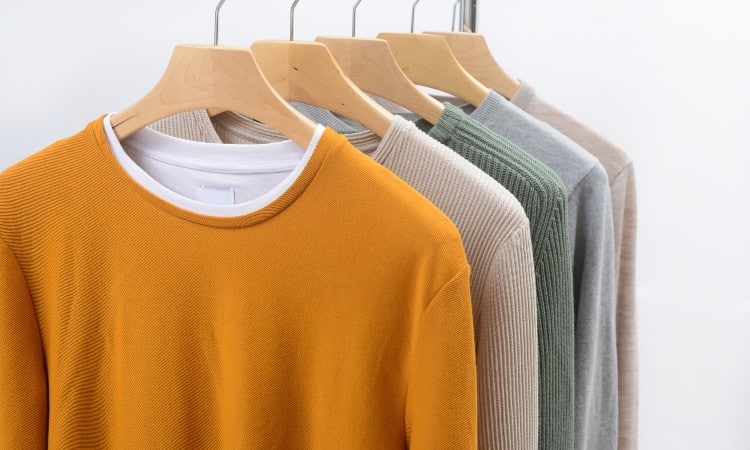
This chart gives you a quick overview of the key differences between a sweater and a sweatshirt.
| Sweater | Sweatshirt | |
|---|---|---|
| Type of Material | Knitted or crocheted fabric made out of many different fibers such as wool, cashmere, or acrylic. | Sweatshirt fleece made out of jersey knit with a brushed inside. |
| Formality | Can vary, ranging from dressy to casual | Always casual |
| Design | Can vary, ranging from turtlenecks to cardigans to crewneck pullovers. | Offers a few design variations such as hoodie vs pullover. |
| Collar | Many different collar styles like V-neck, turtleneck, or off-shoulder. | Ether crewneck or hoodie style. |
| Hem | Many hem variations, as well as many possible lengths. | Always features a ribbed hemline. |
| Closure | Several different closure styles such as pullover, open front, or button front. | Usually either pullover or zipper front. |
| Sleeves | Many sleeve variations such as raglan, cuffed, tight, or loose. | Commonly always have loose sleeves with a ribbed cotton cuff. |
| Warmth | Can vary depending on the looseness of the knit. | Provide great warmth, often worn as an outer layer over a shirt. |
| Thickness | Can vary depending on the diameter of the yarns in the knit fabric. | Can vary depending on the weight of the sweatshirt fleece. |
| Cost | Average price of around $50, but a price range of $20-$400. | Average price of around $50, but a price range of $20 to $200. |
| Best For | Many different settings like business-casual office wear, cozy at-home styles, or dressy church or family gathering styles. | Casual outdoor activities or at-home wear. |
What is a Sweater?
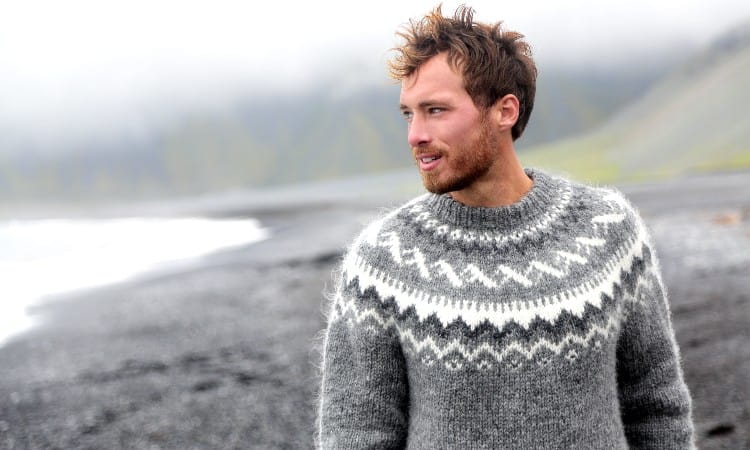
A sweater is a garment worn on the upper body made out of knitted material. Sweaters can feature many different types of material, from thick ropy wool knits to fine, silky cashmere knits. Many sweaters today also contain synthetics like polyester or acrylic, which costs less and provides excellent insulation.
Knitted sweaters can feature actual yarns knitted or crocheted into patterns, but these days they more often use machine-made kitted fabric created by forming continuous loops of intertwined yarns.
A sweater can have a dressy or a casual style depending on what you wear it with and on the cut of the sweater itself. A baggy boyfriend sweater often looks informal, for example, but a fitted cashmere sweater can look quite dressy when paired with slacks and loafers or a skirt and heels.
Sweaters can come in many styles as well. The traditional pullover sweater has a neck opening for the head and pulls on over the head and shoulders just like a t-shirt would. Americans call this type of sweater either a sweater or a pullover, but the British refer to it as a jumper.
The second most popular type of sweater is a cardigan, supposedly named after the 7th Earl of Cardigan, who did not want to mess up his hair with a pullover sweater. Instead, he cut open the front of the sweater and added buttons, creating the cardigan!
You can also find many variations on sweater styles, like the crewneck sweater that looks like a knitted, slightly warmer version of a t-shirt and the turtleneck sweater with its tubular, foldover neck. Sweater dresses have also seen a big surge in popularity recently, as have retro-style sweater vests.
What is a Sweatshirt?
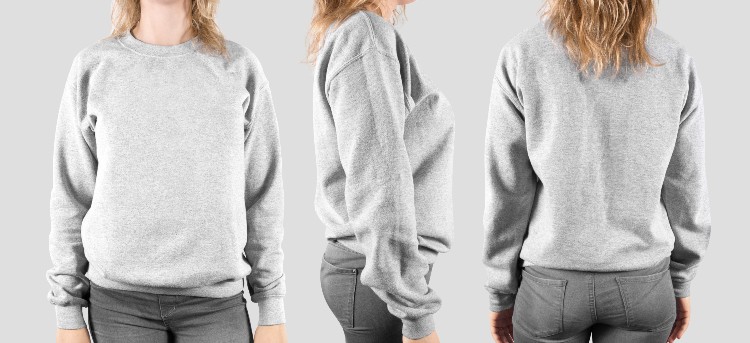
A sweatshirt is a warm garment worn as an outer layer over a shirt, almost always made out of hoodie fleece. This special material has a knitted cotton exterior and a soft fleecy interior fabric. The knitted cotton structure also gives the fabric a bit of stretch.
While most sweatshirts feature this type of fabric, they can come in different weights or thicknesses. Some heavy sweatshirts can replace a coat because they provide so much insulation!
A traditional pullover sweatshirt has long, baggy sleeves that end at a ribbed cuff. It features a crewneck collar just like a t-shirt and often has a ribbed hem to pull the poofy cut of the shirt closer to the waist or hips at the bottom of the garment.
Variations of this traditional style include the popular hoodie, which has a loose hood attached to the neck opening of the sweatshirt and a drawstring to pull it tight. You can also find zip-up sweatshirts as well as zip-up hoodies.
You often find graphic prints like comic book characters, funny sayings, sports team logos, or school colors emblazoned on sweatshirts.
No matter what style variation or print a sweatshirt features, it always has a casual, informal style.
What is the Difference Between Sweater and Sweatshirt?
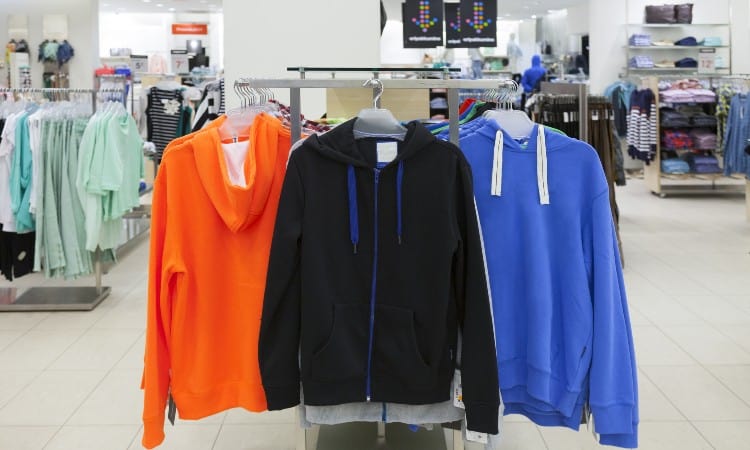
The main difference between a sweater and a sweatshirt is that a sweater contains knitted material and a sweatshirt features knitted cotton fleece. Another key difference is that a sweatshirt is worn as outerwear over a shirt, while a sweater often takes the place of a shirt, though it can sometimes serve as outerwear as well.
The last big distinction between a sweater and a sweatshirt is that a sweater often looks more formal.
Of course, the greatest similarity between these two types of clothing is that they both keep you warm!
Type of Material
One of the main differences between a sweater and a sweatshirt is that a sweater contains knitted or crotched material and a sweatshirt features hoodie fleece.
Sweaters can contain many different types of material. This includes a wide range of wools, from sheep’s wool to cashmere to angora to alpaca or vicuna. But they can also feature knitted cotton yarns for a lightweight summer vibe or durable, warm synthetics like acrylic for a lower cost.
No matter what fiber goes into the yarns that make a sweater, the fabric will have a distinctive knitted or crocheted structure. When you look at a sweater closely, it will have tiny loops that may look like braids or swirls as they interlock together.
This elegant type of cloth can look quite pretty and fancy! It can also have a coarser, puffier structure made out of large yarns for a more casual style.
Sweatshirts, in contrast, always feature one special kind of fabric called brushed cotton knit or hoodie/sweatshirt fleece. This kind of fabric comes from creating a jersey-knit style fabric made from fine interlocked loops of cotton yarn.
This knitted fabric then goes through another machine that uses fine wire bristles to brush one side of the material, raising many tiny fibers out of the fabric to create a soft, fleecy pelt. This means that sweatshirt material looks like t-shirt material on the outside but feels velvety and fuzzy on the inside.
Today, sweatshirts typically contain either cotton or polyester. Cotton has better breathability, but polyester costs less and is more durable.
Formality
Another distinction between sweaters and sweatshirts is that a sweater typically looks much more formal than a sweatshirt.
More precisely, sweaters offer a wide range of formal and informal styles, while sweatshirts have a limited and casual style.
Sweatshirts work well for a morning hike, a day at home, running out to the grocery store, or cheering for your favorite high school sports team from the stands on a chilly fall night.
Sweaters can look great when styled with a business casual outfit, such as slacks and loafers. Or you can pair a cardigan with a sheath dress and heels for a stylish and warm office outfit. On the other hand, you can also wear a baggy thick-knit sweater and jeans for an evening around a campfire or a boyfriend sweater and leggings for a sloppy errand-running style!
One helpful rule of thumb with sweaters is that the thinner and finer the sweater knit, the fancier it will look. Chunky sweaters tend to look more casual and cozy.
Design
Sweaters have more design variation than sweatshirts, making them the more versatile garment for wearing with many different types of outfits.
Sweatshirts can have some design variations, like adding a hood to create a hoodie or adding a zipper to create a front-opening sweatshirt. You may also see sweatshirts with all kinds of cool graphics or prints, such as sports team logos, lettering, or images. But all sweatshirts still feature the same type of hoodie fleece fabric and the same ribbed hem and cuffs on the sleeves.
Sweaters, on the other hand, can come in many different shapes and styles. These range from long sweater dresses to the short, traditional waist-length button cardigan. Sweaters can style outfits like grandma’s twinset, your boyfriend’s sexy business-casual lawyer outfit, or your own scruffy-at-home outfit of an oversized sweater and leggings.
Collar
Sweatshirts and sweaters often have different collar styles because sweatshirts almost always feature a crewneck collar, while sweaters can have many different types of necklines.
A crewneck collar looks exactly like the ribbed cotton neck opening you find on t-shirts, a close-fitting neck opening has a casual and comfortable style.
Some fitted sweaters with fine knit fabric also feature crewneck collars. But sweaters can have many different types of collars, like a turtleneck or mock turtleneck collar, an off-the-shoulder neckline, or a V-shaped neckline.
Hem
Sweatshirts almost always feature a distinctive ribbed knit hem, while sweaters often have a rolled or stitched hem made out of the same material as the rest of the garment. This makes the hem more noticeable on sweatshirts than on sweaters.
Also, sweaters can come in many different lengths, such as waist length, hip length, or even knee length. Sweatshirts typically end at the hips unless you intentionally wear a bigger size to get that oversized hoodie look.
Closure
Sweaters and sweatshirts can have either a pullover style or a variety of different closures, like buttons and zippers.
Sweaters most commonly either have a pullover style with no closure or an open front with buttons as a closure. You can also often find a sweater with an open front and no buttons, meant to wear loosely in a boyfriend cardigan style. Occasionally you may find a sweater with a zipper closure, but you do not see this as often because the looser yarns in the sweater can get caught in the zip.
Sweatshirts commonly either feature a pullover style with a crewneck and no closure or either a quarter-zip opening at the collar or a full front opening with a zipper closure.
Sleeves
Sweaters can have many different sleeve styles, but sweatshirts almost always have the same sleeve style.
Sweatshirt sleeves typically feature a loose cut that tapers to a fitted ribbed cotton cuff at the wrist. This loose style feels roomy and allows plenty of room for movement.
Sweaters can have hundreds of different sleeve styles. You can find sleeveless sweater vests or baggy raglan-style sleeves on some oversized or boyfriend-style sweaters. You can find sweaters that have fold-over cuffs and sweaters that have ribbed cuffs.
You can find turtleneck sweaters with tightly fitted sleeves that stretch around your arm or slightly looser sweater sleeves on dressy crewneck sweaters made of a fine kit material.
Warmth
Sweatshirts sometimes provide more insulation than sweaters, but this can vary depending on the style of the sweater. Sweatshirts have a more protective outer side of the fabric, which helps prevent wind and rain from getting through. The more open-knit structure of many sweaters will not block chilly winds.
Plus, sweatshirts work well as outerwear to layer on top of a shirt. If you want to stay warm while wearing a sweatshirt, pick a sweatshirt made out of heavy 20 oz fabric and wear a thermal shirt as a base layer beneath it. Many sweaters serve in place of a shirt, meaning they do not have extra layers to keep you warm.
On the other hand, some sweaters contain super-insulating types of wool or synthetics like acrylic. These fibers hold heat against your skin and can keep you extremely warm.
Thickness
Both sweaters and hoodies can come in many different thicknesses or weights.
For sweaters, the thickness or weight usually depends on the diameter of the yarn used to knit the material.
For hoodies, look for weight in ounces in the product description. Sweatshirt fleece commonly comes in a light 10 oz version, a midweight 14 oz, or a super heavy 20 oz weight. This means that one square yard of the fabric weighs 10, 14, or 20 ounces.
Cost
The cost for sweaters and sweatshirts can vary a lot based on design elements, the fabric content, and the brand of the garment.
The average price for a sweatshirt is about $50, but this is a little deceptive. Off-brand or discount sweatshirts often cost just $20, but sweatshirts from well-known brands can often cost $100 to $200 instead. Plus, design elements like cool screen prints can also add to the price tag.
Sweater prices also have extreme variation, with the average cost of around $50, once again, not telling the whole story. Cheap sweaters made out of synthetic material like acrylic will likely cost around $20 to $30. On the other end of the spectrum, cashmere or alpaca sweaters often cost $300 to $400!
Best For
Sweaters and sweatshirts both keep you warm, but sweaters work best for more dressy occasions, while sweatshirts work well for casual settings.
You can wear a sweatshirt to a sporting event, a casual outdoor activity like a hike, or for everyday chores around the house.
Depending on the style of your sweater, you can wear it with a dressy outfit to church, a family event, or even to the office for a business-casual style. You can also wear more casual sweater styles for comfortable at-home activities.
Is a Sweatshirt Without a Hood a Sweater?

A sweatshirt without a hood is not a sweater. Actually, a sweatshirt without a hood is simply the most traditional type of sweatshirt featuring a crewneck collar! This pullover style remains popular today even though the hoodie style is also appealing.
The big difference between a sweatshirt without a hood and a sweater is that they contain different fabric types. A sweater features knitted or crotched fabric and a sweatshirt contains fuzzy sweatshirt fleece.
Is a Sweatshirt Enough for Winter?
Whether or not a sweatshirt is enough for winter depends on many factors, like the average winter temperatures where you live and the weight of the sweatshirt fleece in the garment.
Sweatshirts can take the place of a coat to keep you warm in milder winter temperatures. However, sweatshirt fleece has no water resistance and could easily get damp in the snow. Sweatshirt fleece also provides some resistance to the wind but does not completely prevent cold air from getting through because of its stretchy, knitted outer surface.
Finally, sweatshirt fleece comes in varying weights, as you know from earlier in this article. Heavier-weight sweatshirts will keep you much warmer than lightweight sweatshirts.
Sweater and Sweatshirt Compared
Another helpful way to understand the difference between a sweater and a sweatshirt is to compare these garments to similar clothing styles.
Sweatshirt vs Crew Neck
A sweatshirt and a crew neck can mean the same thing! Traditional pullover sweatshirts have a crewneck collar. This means a round neck opening with a facing made of ribbed material.
Many garments can feature a crew neck, so the term does not always mean a sweatshirt. T-shirts often have crewneck collars, for example. Some sweaters also have a crewneck collar.
Sweater vs Sweatshirt vs Hoodie
The main difference between a sweater, a sweatshirt, and a hoodie is that a sweater contains knitted fabric and has many style variations, while a sweatshirt and hoodie both feature knitted fleece.
Technically, a hoodie is a type of sweatshirt that has an attached hood instead of a crewneck collar.
Sweater vs Sweatshirt vs Pullover
Both sweaters and sweatshirts can go by the name of a pullover! This sounds confusing, but “pullover” refers to a style of garment that you pull on over your head and shoulders instead of opening it in the font and then closing it with a zipper or buttons.
In some parts of the word, the term “pullover” specifically means a pullover sweater, though. You more commonly call a sweatshirt either a sweatshirt or a crewneck when it has this pullover style with no front opening.
Sweatshirt vs Jacket
The main difference between a sweatshirt and a jacket is that a jacket always has a front opening and often provides more protection from the weather.
You can find many different styles of jackets, ranging from rain jackets to puffer jackets to sports jackets. But most jackets serve as a shorter and less insulating version of a coat.
Sweatshirts have a more casual, baggy shape than most jackets. They also often feature a pullover style instead of a front opening with a zipper closure. Plus, sweatshirts contain a soft knitted material that will soak up rain instead of protecting from the weather.
Sweatshirt vs Long-Sleeve
The main difference between a sweatshirt and a long-sleeve shirt is that most long-sleeve shirts do not have soft, fuzzy fleece on the inside.
Another difference is that most long sleeve shirts use a lightweight jersey knit fabric, making them look like a t-shirt with long sleeves rather than a baggy, looser piece of outerwear like a hoodie or sweatshirt.
Finally, you commonly wear a sweatshirt over top of a shirt, while a long-sleeve shirt works as a shirt on its own and would not easily fit over the top of another garment.
When to Wear a Sweater vs a Sweatshirt

When to wear a sweater vs a sweatshirt depends on the formality of the occasion and the warmth of the weather. Check out this list for some helpful tips!
Wear a sweater:
- For dressy family or holiday events, wear a fine-knit, close-fitting sweater such as a turtleneck or crewneck cut. Pair this dressy top with slacks and nice shoes. Alternatively, pick a holiday-themed but more casual sweater, such as the American trend for ugly Christmas sweaters!
- For the workplace, wear a dressy sweater such as a cashmere pullover with either a midi skirt or tailored slacks. Fitted sweaters made of good-quality material can look extremely stylish and more laid back than a suit and tie.
- For a cozier style, layer a cardigan over almost any outfit, ranging from a sheath dress at work to jeans and a t-shirt at home! Or toss a baggy oversized sweater over a tank top and jeans for a day at home on the couch.
Wear a sweatshirt for casual occasions or outdoor events, like:
- Layer a sweatshirt or hoodie over a thermal base layer for a chilly winter hike or camping trip. Or zip a zipper sweatshirt over your shirt for an evening campfire in the fall.
- Wear a sweatshirt for messy chores or yardwork in early spring or late fall. You can easily wash a sweatshirt, so you don’t have to worry about it getting dirty!
- Wear a sweatshirt with your school or sports team logo to appropriate school events or cheer for your child’s sports team.
Which is Better: Sweatshirt or Sweater?
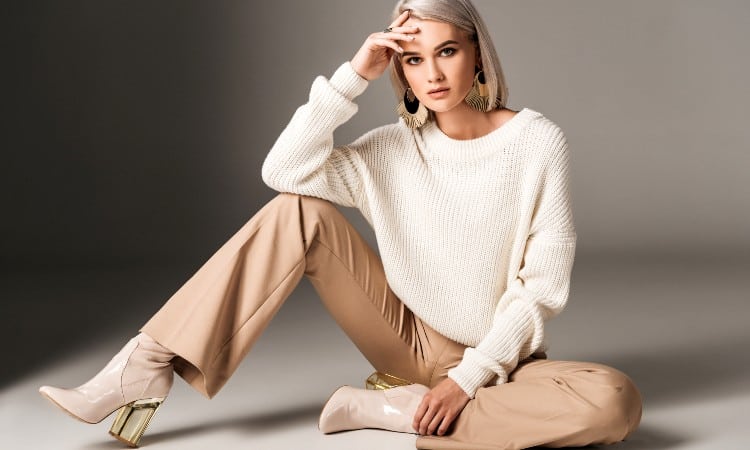
Whether or not a sweatshirt or a sweater is better depends on the occasion and your preference. Both garments can keep you warm and have the same average price point of roughly $50. But each garment also has its own advantages.
Sweaters have more versatility than sweatshirts because they come in so many different styles. This also means that sweaters can work well for formal events and casual events, depending on the style you pick. Plus, some sweaters can serve as outerwear while others replace a shirt.
Of course, sweatshirts also have many advantages! Sweatshirts have a roomy shape that allows for comfortable movement while keeping you warm. Sweatshirts always have a casual style but often feature fun design elements like graphics, logos, or lettering.
The bottom line is that if you want casual comfort, a sweatshirt will probably work best for you. If you want a unique style or a dressy outfit, wear a sweater instead.